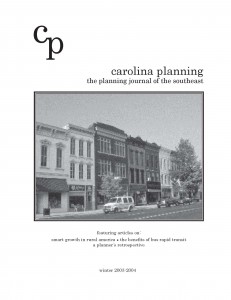 Volume 29.1 Smart Growth and Rural America (2004)
Volume 29.1 Smart Growth and Rural America (2004)
Editors: Helen Chaney, Naomi Cytron, Adena Messinger, and Jane Sibley
A digital version of this issue is available here.
| SMART GROWTH: HOW IT IS HELPING RURAL AMERICA
Levofsky, Amber Over the last several decades, rural populations have been growing at an exponential rate. While some rural communities have accommodated this growth through low-density development, other areas are employing smart growth techniques in an effort to preserve open space, ensure adequate affordable housing, integrate land use and transit, and encourage compact, mixed-use development. This article identifies the growing pains common among rural communities and highlights the accomplishments of seven communities that have successfully leveraged development strategies for the betterment of their communities.
|
| PLANNING NEWS BRIEFS: EPA SMART GROWTH AWARD FOR WAKE CO. SCHOOL, HILLSBOROUGH DESIGN COMPETITION
Carolina Planning Journal Editors |
| PLANNER PROFILE: ROGER S. WALDON, AICP, PLANNING DIRECTOR, TOWN OF CHAPEL HILL
Carolina Planning Journal Editors |
| ANALYSIS OF BOGOTÁ’S BUS RAPID TRANSIT SYSTEM AND ITS IMPACT ON LAND DEVELOPMENT
Targa, Felipe; Rodriguez, Daniel A. Recent experiences in Latin American cities supporting world-class public transportation systems have resulted in the creation of livable spaces with a significant potential to spur land development. In cities like Bogotá, Colombia, and Curitiba, Brazil, bus rapid transit (BRT) has re-emerged as a cost-effective transportation alternative for satisfying growing demands for urban mobility. Bogotá’s BRT system has allowed for a 32 percent reduction in average travel times and significant reduction in accident and air pollution levels along the busway corridors. Although previous research suggests that the impacts of access to BRT facilities on the nearby land value and use have been minor, new BRT systems like the one in Bogotá feature intensive infrastructure facilities and their effects in terms of accessibility and mobility have been impressive. This paper provides first-hand empirical evidence on the evaluation of how the BRT system is related to land development outcomes such as land values. Future BRT extensions will have a large potential to influence future land development and induce desirable urban forms and land uses around stations and busway corridors. |